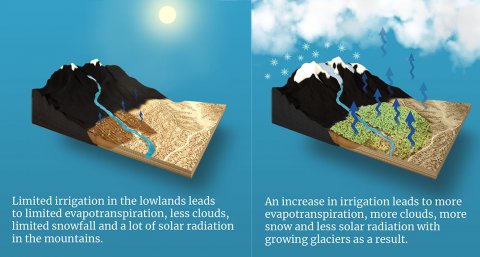Increasing irrigation may lead to growing glaciers
It has been a mystery for years: while glaciers are shrinking all over the world, there is an area in the Asian high mountains where the glaciers are actually growing. New Utrecht University research shows that humans might be responsible for this. The increasing agricultural activity in the region is resulting in more snow and less sunlight in the mountains, precisely in the areas where the glaciers are growing.
The vast majority of glaciers in the high mountains of Asia are partially melting away due to global warming. But there’s an area to the northwest of the Tibetan Plateau where the glaciers are actually growing. ‘Because the region is difficult to access, little has been known about these glaciers for quite some time’, says first author Remco de Kok, a physical geographer at Utrecht University. ‘But with the help of weather models we have shown that these glaciers can expand because local land use has changed. The fact that human activity can have such an immediate impact on the growth of glaciers is new information, and extremely important to know for the many people who depend on the meltwater from glaciers.’ The results of the study were published this week in the journal Geophysical Research Letters.

The increasing irrigation in the region is the cause of this remarkable glacier growth. Research leader Walter Immerzeel explains: ‘In the lowlands of China, Pakistan and India, river and groundwater are increasingly being used to irrigate agricultural areas. Much of the irrigation water is eventually “sweated out” by the plants and absorbed into the atmosphere. Using a special weather model, we have shown that the increasing water vapour later comes down as additional snow – precisely in the places where the growing glaciers are found. The additional clouds also allow less sunlight to pass through, causing the glaciers to melt at a slower rate.’
´If irrigation decreases, the effect will be undone´
The ice supply in the Asian high mountains is crucial to the many millions of people who depend on the meltwater. The results of this study are primarily good news, although the research group, which also consists of Pleun Bonekamp and ObbeTuinenberg, warns against too much optimism. ‘Due to the limited amount of river and groundwater, the question is to what extent agriculture in Asia can continue to grow in the future. If irrigation decreases, the effect will be undone and it is likely that – in combination with the further warming of the earth – the glaciers will retreat at an accelerated pace.’
Walter Immerzeel’s research group recently published an article in Nature about the fact that one-third of the glaciers in Asia will melt.

